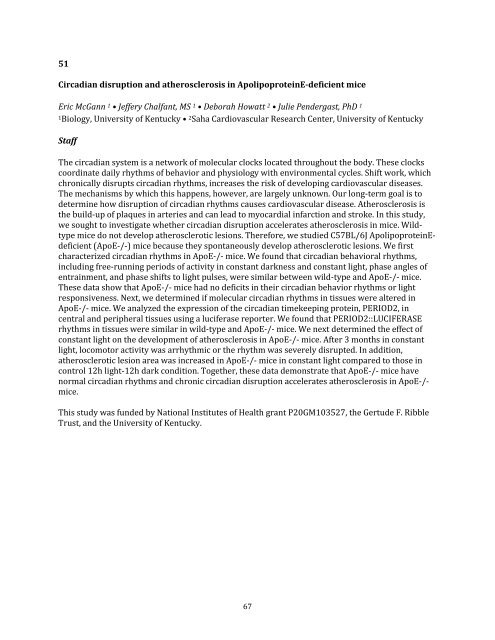2017 Cardiovascular Research Day Abstract Book
Create successful ePaper yourself
Turn your PDF publications into a flip-book with our unique Google optimized e-Paper software.
51<br />
Circadian disruption and atherosclerosis in ApolipoproteinE-deficient mice<br />
Eric McGann 1 • Jeffery Chalfant, MS 1 • Deborah Howatt 2 • Julie Pendergast, PhD 1<br />
1Biology, University of Kentucky • 2 Saha <strong>Cardiovascular</strong> <strong>Research</strong> Center, University of Kentucky<br />
Staff<br />
The circadian system is a network of molecular clocks located throughout the body. These clocks<br />
coordinate daily rhythms of behavior and physiology with environmental cycles. Shift work, which<br />
chronically disrupts circadian rhythms, increases the risk of developing cardiovascular diseases.<br />
The mechanisms by which this happens, however, are largely unknown. Our long-term goal is to<br />
determine how disruption of circadian rhythms causes cardiovascular disease. Atherosclerosis is<br />
the build-up of plaques in arteries and can lead to myocardial infarction and stroke. In this study,<br />
we sought to investigate whether circadian disruption accelerates atherosclerosis in mice. Wildtype<br />
mice do not develop atherosclerotic lesions. Therefore, we studied C57BL/6J ApolipoproteinEdeficient<br />
(ApoE-/-) mice because they spontaneously develop atherosclerotic lesions. We first<br />
characterized circadian rhythms in ApoE-/- mice. We found that circadian behavioral rhythms,<br />
including free-running periods of activity in constant darkness and constant light, phase angles of<br />
entrainment, and phase shifts to light pulses, were similar between wild-type and ApoE-/- mice.<br />
These data show that ApoE-/- mice had no deficits in their circadian behavior rhythms or light<br />
responsiveness. Next, we determined if molecular circadian rhythms in tissues were altered in<br />
ApoE-/- mice. We analyzed the expression of the circadian timekeeping protein, PERIOD2, in<br />
central and peripheral tissues using a luciferase reporter. We found that PERIOD2::LUCIFERASE<br />
rhythms in tissues were similar in wild-type and ApoE-/- mice. We next determined the effect of<br />
constant light on the development of atherosclerosis in ApoE-/- mice. After 3 months in constant<br />
light, locomotor activity was arrhythmic or the rhythm was severely disrupted. In addition,<br />
atherosclerotic lesion area was increased in ApoE-/- mice in constant light compared to those in<br />
control 12h light-12h dark condition. Together, these data demonstrate that ApoE-/- mice have<br />
normal circadian rhythms and chronic circadian disruption accelerates atherosclerosis in ApoE-/-<br />
mice.<br />
This study was funded by National Institutes of Health grant P20GM103527, the Gertude F. Ribble<br />
Trust, and the University of Kentucky.<br />
67


